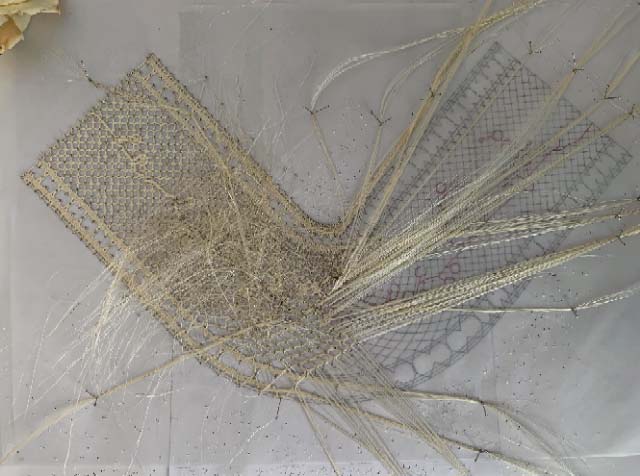Today I wanted to share a peek at what Rowan Panther is working on for this exhibition.
Rowan describes herself as a lace textile artist. She began by learning about bobbin lace making from influential lacemaker Alwynne Crowsen. Over time, Rowan began to consider how she might combine this European practice with her Samoan whakapapa – and many of her pieces reference breastplates, collars, and other forms found in Moana adornment.
Like Neke Moa, who is also making work for this exhibition, Rowan works with muka (harakeke fibre). The processed muka fibres are a glossy, luminous, cream-white. Although they are fairly strong, they have a visual delicacy, offset in Rowan’s work by pieces of silver, and brought into balance by the imposing scale of the finished pieces, and the inclusion of hard materials such as shell and wood.
This exhibition explores how makers reinterpret the ideas and techniques they’ve inherited, so including Rowan was an obvious choice. She spends a lot of time looking at books about lacemaking and taonga in museum collections in the lead-up to creating each series of work.

In the photo above, you can see some of the images Rowan has put up to refer to as she works. Included are photos of masi (FE000269), siapo (FE001420), lace (PC000331), and hiapo (FE000278) from Te Papa’s collections (the bits in brackets are the registration numbers, if you want to look them up on the Te Papa website. The three lace images are from a book called 100 traditional bobbin lace patterns by Geraldine Stott and Bridget Cook. These are intermingled with photocopies of native plants that Rowan has collected locally: Muehlenbeckia/Pohuehue, Kauri, and Kawakawa.
For this exhibition, Rowan wanted to try out a technique typically used to create lace borders. A design is woven through the border using ‘thick gimpwork’. Rowan is using this technique to pick out designs inspired by some of the plants that surround her in Doubtless Bay, Northland, where she lives and works.
I hope this whets your appetite for the finished pieces! Some of the other makers in this exhibition share an interest in textiles, so I’ll write a bit more about that connection in future posts, too. Stay tuned!
— Emma
